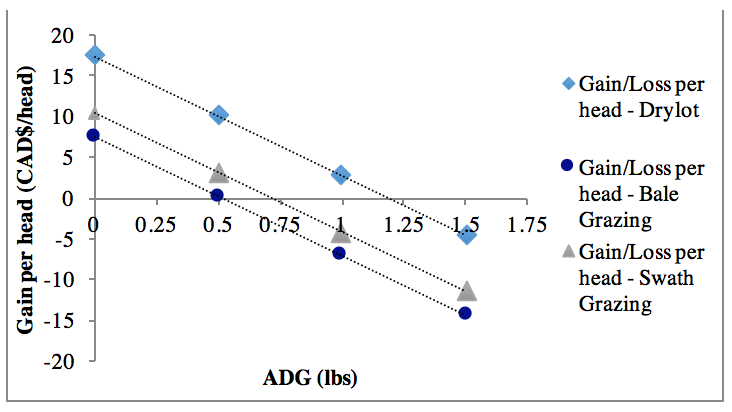Pregnancy Detection
Pregnancy detection (preg-checking) has been used in the beef industry for more than 60 years. There are many reasons for producers to preg-check including to evaluate herd and bull fertility, to help monitor herd reproductive health, to determine approximate calving dates, and to help determine how best to sort cows into management groups.
Preg-checking also gives producers the opportunity to save the cost of overwintering non-pregnant (open) cows. Heat detection alone may not be enough to determine pregnancy as some cattle continue to show signs of ‘false heat’ after they have been bred.
Sections
Methods of Pregnancy Detection
Several methods can be used for testing pregnancy in cattle. The most common are ultrasound, manual palpation, and blood samples.
Manual palpation
Palpation can determine pregnancy as early as 35-45 days by feeling the uterus and ovaries through the rectal wall. Experienced veterinarians are able to estimate stage of pregnancy and approximate a calving date.
Having a defined breeding season and removing bulls from a breeding pasture weeks before preg-checking will help to increase testing accuracy and eliminate the question of whether cows are open or bred fewer than 45 days before the exam.
Ultrasound
Ultrasound uses a probe to emit and receives sound waves aimed at the uterus to create an image. When sound waves contact solid tissue, like bone, they bounce back and appear white on the monitor. Sound waves pass through fluids so do not return to the probe and therefore appear black in the image. Various densities of tissue appear in shades of grey.
Ultrasound can detect pregnancy as early as 13-21 days. Pregnancy detection with ultrasound requires less manipulation of the uterus, and previous studies have shown that pregnancy loss was 1% lower in heifers that were preg-checked using ultrasound vs. manual palpation.
Compared to manual palpation, ultrasound is also more accurate at determining fetal age, can determine viability of the pregnancy, detect twins, and identify the sex of the fetus(es).
Blood samples
Detecting pregnancy with blood samples uses a lab test that detects pregnancy specific proteins. The blood sample can be taken by a producer from the tail vein then sent to a lab for analysis. Pregnancy testing through blood tests works well for producers that seldom get on-farm veterinarian visits because of limited availability in or high travel costs to their location.
Blood samples can be taken as early as 28 days and there is no risk of transferring venereal diseases between cows. Because samples must be sent to a lab for analysis, results may not be returned to producers for days or weeks. Therefore, cows will need to be brought in twice if producers want to sort cows into management groups based on pregnancy, or to cull non-pregnant cows.
Economics
The 2015 Western Canadian Cow-Calf Survey reported that 60% of producers include preg-checking as part of their management strategy. While this is 49% higher than the 1997/98 Alberta Cow-Calf Survey results, the question remains as to why 40% of producers in Western Canada choose not to preg-check their cows.
Assuming a spring calving schedule, generally producers have three options for managing open cows:
1) Preg-check cows in the fall and cull opens immediately
- Pros: Realize value of cull cows in the fall and avoid incurring costs of overwintering open cows.
- Cons: Incur vet costs and forgo the value of cull cows in spring during higher market prices.
2) Preg-check in the fall and feed open cows separately to market at a later date
- Pros: Avoids selling during the lower market prices during the fall and adds weight to cull cows before they’re sold.
- Cons: Incur vet costs, absorb overwintering costs for open cows, and supplemental feed costs.
3) Do not preg-check - overwinter all cows together and cull opens in the spring after the herd has finished calving.
The economics of preg-checking and selling cull cows depends on:
- cull cow market price,
- the management system employed by the producer,
- feed and overhead costs, and
- veterinary costs.
Calculator: Economics of Pregnancy Testing Beef Cattle
To help producers choose the most economical option for their operation, the following economics of preg-checking model was developed by Ben-Ezra and Muzzin (2015). The model accounts for these factors and assists cow-calf producers determine which of the three above options makes the most sense for their operation.
A basic and advanced version are available. Both versions have the option to enter parameters for feeding cull cows as a separate group.
Discussion: how alternative feeding options and market decisions impact producer decisions
Using the model, the developers made several conclusions:
Conclusion #1: The higher a producer’s feed and overwintering costs, the more favourable preg-checking and culling cows is in the fall.

Conclusion #2: The ADG of cull cows over the winter feeding period has a significant impact on the cow’s spring value; higher weight gains over the winter result in higher spring values than low weight gains, regardless of the market price. ADG varies with the management system (i.e. traditional drylot vs. swath grazing vs. bale grazing). However, not every producer will realize the same ADG using the same management system due to other factors including cattle genetics or environmental conditions like harsh winter versus mild winter.
|
Management System |
Breakeven ADG (lbs/day) |
ADG (lbs/day) From Literature |
Decision |
|
Drylot mixed hay |
1.20 |
1.44 |
Sell in the spring |
|
Swathed barley grazing |
0.70 |
0.58 |
Preg-check and sell in the fall |
|
Bale grazing |
0.50 |
0.88 |
Sell in the spring |
Conclusion #3: High cull cow prices and ADG favour overwintering cows until the following spring as every pound of gain is more valuable.
Cattle market price is a much stronger driver of the economics of preg-checking than overwintering costs. Over the last ten years producers have not benefited from preg-checking and culling open cows in the fall. The loss of potential income experienced by producers for preg-checking and culling open cattle in the fall was driven largely by cattle prices increasing seasonally and annually. This may explain the significant segment of producers who still do not preg-check their herds.
Consistently higher cull-cow prices in the spring can be a strong deterrent to preg-checking. Producers in Western Canada that have overwintered their open cattle have received, on average (2005 to 2014), a market price 25.6% higher than the previous fall (October to March). However, the seasonality is quite variable, ranging from 6% in 2006-2007 to 53% in 2009-2010.
Conclusion #4: At current market prices, the strategy of preg-checking and feeding the open cow group a high-energy ration for 90 days provides the greatest economic benefit to producers – a gain of $5.16/head compared to overwintering. As cow prices have increased annually over the last decade, from the 2003 low, preg-checking has not been economically beneficial and producers have seen the greatest benefit from overwintering cattle and selling at the higher price.
Conclusion #5: Should cull cow prices drop to pre-2012 levels (below $0.75/lbs), many scenarios indicate that preg-checking and culling in the fall is a better option as the cost of overwintering begins to outweigh the benefit of selling heavier cull cows in the spring.



 View PDF
View PDF


